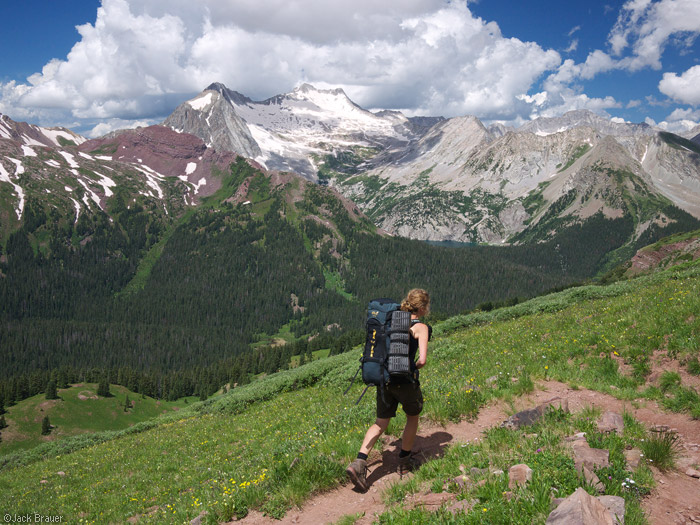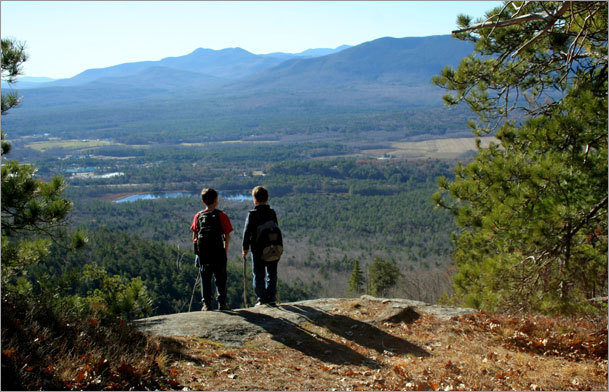TIPS FOR HIKING ON MOUNTAINS
 As I trekked on the Ridge Trail at Telluride the main sounds were the clattering of the cicadas, ear-splitting tweets of unidentified winged creatures and the shuddering of the aspen leaves as the wind cleared through them. Flashes of light through thick pines highlighted small purple blossoms at my feet and patches of green lichen on fallen logs. The far perspective through trees that towered 50 - to 60 feet overhead uncovered sheer striated bluff groups still topped by snow in July.
As I trekked on the Ridge Trail at Telluride the main sounds were the clattering of the cicadas, ear-splitting tweets of unidentified winged creatures and the shuddering of the aspen leaves as the wind cleared through them. Flashes of light through thick pines highlighted small purple blossoms at my feet and patches of green lichen on fallen logs. The far perspective through trees that towered 50 - to 60 feet overhead uncovered sheer striated bluff groups still topped by snow in July.
 When beginning, get data about the trail you need to take at the traveler data office or stall, the Forest Ranger's station or a nearby store that offering climbing and biking rigging. Take any buff neighborhood's recommendation precisely - on the off chance that he or she says the trail is simple, it may be for them by not for work area-tied down city people.
When beginning, get data about the trail you need to take at the traveler data office or stall, the Forest Ranger's station or a nearby store that offering climbing and biking rigging. Take any buff neighborhood's recommendation precisely - on the off chance that he or she says the trail is simple, it may be for them by not for work area-tied down city people.
 Choose ahead of time on the off chance that you need to invest a large portion of your time trekking tough, downhill, or both. Sounds self-evident, yes? Be that as it may, take the Ridge Trail as an illustration of what's not effectively clear. The name and the guide recommends you are strolling on an edge line. While that was genuine, I pick the course (unknowingly I concede yet cheerfully I later understood), that was very nearly totally downhill. I realized this from the gathering I met, who had been relentlessly moving since they began at the flip side of the Ridge trail. Indeed their pooch was gasping vigorously.
Choose ahead of time on the off chance that you need to invest a large portion of your time trekking tough, downhill, or both. Sounds self-evident, yes? Be that as it may, take the Ridge Trail as an illustration of what's not effectively clear. The name and the guide recommends you are strolling on an edge line. While that was genuine, I pick the course (unknowingly I concede yet cheerfully I later understood), that was very nearly totally downhill. I realized this from the gathering I met, who had been relentlessly moving since they began at the flip side of the Ridge trail. Indeed their pooch was gasping vigorously.
Climbing mountains brings you up close with nature, from the clearing perspectives of pine-bordered tops and stark shake bluffs above tree line to the vivid appearances of little blossoms at your feet and a songbird's whistle. Anyhow mountain trekking takes thought and arranging, regardless of the fact that you're simply climbing for a couple of hours or a day on trails laid out in a guide at a resort in the Rocky Mountains.
 As I trekked on the Ridge Trail at Telluride the main sounds were the clattering of the cicadas, ear-splitting tweets of unidentified winged creatures and the shuddering of the aspen leaves as the wind cleared through them. Flashes of light through thick pines highlighted small purple blossoms at my feet and patches of green lichen on fallen logs. The far perspective through trees that towered 50 - to 60 feet overhead uncovered sheer striated bluff groups still topped by snow in July.
As I trekked on the Ridge Trail at Telluride the main sounds were the clattering of the cicadas, ear-splitting tweets of unidentified winged creatures and the shuddering of the aspen leaves as the wind cleared through them. Flashes of light through thick pines highlighted small purple blossoms at my feet and patches of green lichen on fallen logs. The far perspective through trees that towered 50 - to 60 feet overhead uncovered sheer striated bluff groups still topped by snow in July.
I met only one other gathering of explorers on this typically mainstream trail, so while I strolled along some climbing tips started rattling through my mind.
 When beginning, get data about the trail you need to take at the traveler data office or stall, the Forest Ranger's station or a nearby store that offering climbing and biking rigging. Take any buff neighborhood's recommendation precisely - on the off chance that he or she says the trail is simple, it may be for them by not for work area-tied down city people.
When beginning, get data about the trail you need to take at the traveler data office or stall, the Forest Ranger's station or a nearby store that offering climbing and biking rigging. Take any buff neighborhood's recommendation precisely - on the off chance that he or she says the trail is simple, it may be for them by not for work area-tied down city people.
Pick trails precisely, so youthful children can't get into a bad situation, by strolling into the forested areas or off a bluff.
 Choose ahead of time on the off chance that you need to invest a large portion of your time trekking tough, downhill, or both. Sounds self-evident, yes? Be that as it may, take the Ridge Trail as an illustration of what's not effectively clear. The name and the guide recommends you are strolling on an edge line. While that was genuine, I pick the course (unknowingly I concede yet cheerfully I later understood), that was very nearly totally downhill. I realized this from the gathering I met, who had been relentlessly moving since they began at the flip side of the Ridge trail. Indeed their pooch was gasping vigorously.
Choose ahead of time on the off chance that you need to invest a large portion of your time trekking tough, downhill, or both. Sounds self-evident, yes? Be that as it may, take the Ridge Trail as an illustration of what's not effectively clear. The name and the guide recommends you are strolling on an edge line. While that was genuine, I pick the course (unknowingly I concede yet cheerfully I later understood), that was very nearly totally downhill. I realized this from the gathering I met, who had been relentlessly moving since they began at the flip side of the Ridge trail. Indeed their pooch was gasping vigorously.
Continuously check the nearby climate report to check whether electrical storms are anticipated. (They regularly begin toward the evening.) Take your trek promptly in the day. In the event that it begins thundering and lightening, head back up.
Some trail maps, particularly at resorts, demonstrate whether the trail is only for explorers, just for mountain bikers, or for both. In the event that you incline toward calm and not needing to stress over always moving a couple of steps off the trail so bicyclists can get past, pick a way likewise.
We're on the whole that we ought to never climb alone. This is surely genuine in the back country. On resort trails, nonetheless, I've seen numerous individuals trekking alone (and I was climbing alone that day). In either case, dependably let somebody at home or a companion know precisely which trails you are anticipating taking. On the off chance that you harm yourself and can't return to the trail head, individuals will know where to begin searching for you. Living in the Rockies, throughout TV news hours we regularly become aware of triumphs in discovering lost or damage climbers and of awful endings, once in a while in light of the fact that nobody knows where to search.

No comments:
Post a Comment